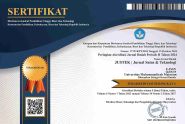Analisis Logam Berat Sedimen Wilayah Kota Balikpapan Berdasarkan Geo-Accumulation Index (Igeo)
Abstract
Abstract: Balikpapan City, East Kalimantan as a buffer zone of Indonesia's new National Capital City (IKN) has a big challenge on environmental aspects, especially heavy metal pollution in Balikpapan City sediments. This study was conducted to determine the concentration and the status of heavy metal pollution level in sediments of Balikpapan City based on geo-accumulation Index (Igeo) using geochemistry data. The samples used in the study were 20 sediment samples from 6 sampling locations in Balikpapan City. The particle size of sediment found in the study area is coarse to very fine which consists of sandy clay, Quartz sand, siltstone, coal embedded, and lignite. Based on the results of geo- accumulation index (Igeo) calculation, it is obtained that the metals Cr, Ni, Cu, and Zn are in class 0 (Igeo ≤ 0) indicating that sediment samples in Balikpapan City area are not polluted by these metals, and the metals Cd, Pb, Fe and Mn have a high value (Igeo ≥ 6) indicating that these metals are extreme polluted in sediments of Balikpapan City area.
Abstrak: Kota Balikpapan, Kalimantan Timur sebagai zona penyangga Ibu Kota Negara (IKN) baru Indonesia memiliki tantangan besar pada aspek lingkungan terutama pencemaran logam berat yang terdapat pada sedimen di wilayah Kota Balikpapan. Penelitian ini dilakukan untuk mengetahui konsentrasi dan status tingkat pencemaran logam berat dalam sedimen Kota Balikpapan berdasarkan Geoaccumulation Index (Igeo) menggunakan data geokimia. Sampel yang digunakan dalam penelitian tersebut berjumlah 20 sampel sedimen dari 6 titik lokasi pengambilan sampel di wilayah Kota Balikpapan. Ukuran partikel sedimen yang terdapat pada daerah penelitian berukuran kasar hingga sangat halus yang terdiri atas lempung pasiran, pasir kuarsa, batulanau, sisipan batubara, dan lignit. Berdasarkan hasil perhitungan indeks geoakumulasi (Igeo) didapatkan untuk logam Cr, Ni, Cu, dan Zn kurang dari nol (Igeo ≤ 0) yang mengindikasikan bahwa sampel sedimen pada wilayah Kota Balikpapan tidak terpolusi oleh logam ini, sedangkan logam Cd, Pb, Fe dan Mn mempunyai nilai yang tinggi (Igeo ≥ 6) yang mengindikasikan logam tersebut ekstrim tercemar pada sedimen wilayah Kota Balikpapan.
Keywords
Full Text:
PDFReferences
Aloupi, M., Angelidis, M.O., (2001). Geochemistry of natural and anthropogenic metals in the coastal sediments of the island of Levos, Aegean Sea. Environmental Pollution. 113: 211- 219.
Cox, R., Lowe, D.R., And Cullers, R.L. (1995). The influence of sediment recycling and basement composition on evolution of mudrock chemistry in the southwestern United States: Geochimica et Cosmochimica Acta, 59; 2919–2940. http://dx.doi.org/10.1016/0016- 7037(95)00185-9.
Darmono. (1995). Logam Dalam Sistem Biologi Makhluk Hidup. Jakarta: UI Press
Dewi, G.A., Samson, S.A., dan Usman, U., (2018). Analisis kandungan logam berat Pb dan Cd di Muara Sungai Manggar Balikpapan. ECOTROPHIC : Jurnal Ilmu Lingkungan. 12 (2): 117- 124
Friedman, G.M. dan Sanders, J.E. (1978). Principles of Sedimentology. New York: Wiley. Frank, Lu C., (2006). Toksikologi Dasar. Jakarta: UI Press
Hidayat, S., Umar, I., (1994). Peta Geologi Lembar Balikpapan, Kalimantan Timur. Bandung: Pusat Survei Geologi
Kar. D, Sur. P, Mandai. S.K. Saha, T, Kole R. K., (2008): Assessment of heavy metal pollution in surface water. Int. J. Environ. Sci. Technol. 5: 119–124.
Jarup L., (2003). Hazards of heavy metal contamination. Br Med Bull. 68 (1): 167–182
Kalnicky, D.J., Singhvi, (2001). R. Field Portable XRF Analysis of Environmental Samples. J. Hazard.
Mater. 83: 93–122.
Karya, P. C., (2016). Laporan Final Bantuan Teknis Pendampingan Penyusunan Dokumen RPIJM Kota Balikpapan. Balikpapan: Direktorat Jenderal Cipta Karya Departemen Pekerjaan Umum, 2016.
Luthfi, M., Sunarwan, B., (2009). Tinjauan Geologi Terhadap Potensi dan Tingkat Kerawanan Bahaya Longsor Di Kota Balikpapan-Kalimantan Timur. Jurnal Teknologi, II (14): 9-28.
Rabee, A. M., Al-Fatlawy, Y. F., Abd, A.-A.-H. N., dan Nameer, M., (2011). Using Pollution Load Index (PLI) and Geoaccumulation Index (I-Geo) for the Assessment of Heavy Metals Pollution in Tigris River Sediment in Baghdad Region, J. of Al-Nahrain Univ. Sci. 14 (4): 108–114.
Rubio, B, Nombela, M.A. and Vilas, F., (2000). Geochemistry of major and trace elements in sediments of the Ria de Vigo (NW Spain): an assessment of metal pollution, Marine Pollution Bull. 40: 968-980
Shams, M. T., Ray, S., Kabir, M. I., dan Purkayastha, T., (2012). Assessment of Heavy Metal Contamination in Incinerated Medical Waste. ARPN Journal of Science and Technology. 2 (10): 904–911.
Singovszka, Eka, (2017). Metal Pollution Indices of Bottom Sediment and Surface Water Affected by Acid Mine Drainage. Slovakia: Institue of Environment Engineering, Technical University of Kosice.
Sitorus S., Ilang Y., dan Nugroho R. A., (2020). Analisis kadar logam Pb, Cd, Cu, As pada air, sedimen dan bivalvia di Pesisir Teluk Balikpapan. Dinamika Lingkungan Indonesia, 7(2): 89-94
Subramanian, V., Mohanachandran G., (1990). Heavy metals distribution and enrichment in the sea sediments of southern east coast of India. Mar. Pollut. Bull. 21 (7): 324-330.
Sukandarrumidi, (2009). Memahami Pengelolaan Bahan Tambang di Indonesia. Yogyakarta: Yayasan Pustaka Nusantama.
Turekian, K.K. dan Wedepohl, K.H., (1961). Distribution of the Elements in Some Major Units of
the Earth’s Crust, Geol. Soc. of Am. Bull., 72:175-192.
Yudo S., (2006). Kondisi pencemaran logam berat diperairan sungai DKI Jakarta. Jurnal Air Indonesia. 2 (1): 1-15
Zanganeh A.H.P., Lakhan. V. C, Vazyari, M., (2008). Geochemical Assosciations and Grain Sise Partitioning of Heavy Metals in Nearshore Sediments Along the Iranian Coast of the Caspian Sea. J. Science. 35:192-202.
DOI: https://doi.org/10.31764/justek.v6i4.19713
Refbacks
- There are currently no refbacks.
JUSTEK : Jurnal Sains dan Teknologi sudah terindeks
EDITORIAL OFFICE:












.JPG)

